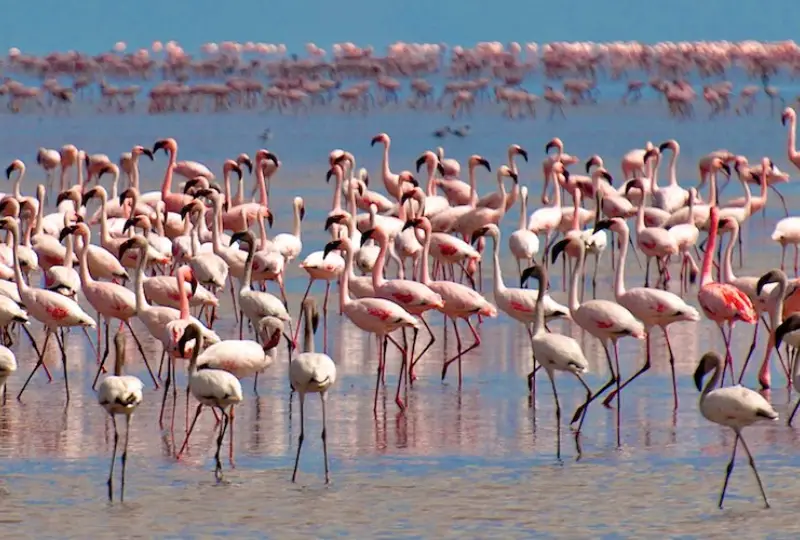Lake Manyara National Park Overview
Lake Manyara National Park is a stunning safari destination located in northern Tanzania, famous for its breathtaking scenery, diverse ecosystems, and abundant wildlife. Nestled at the base of the Great Rift Valley escarpment, the park stretches over 330 square kilometers and includes the shimmering alkaline Lake Manyara, lush groundwater forests, acacia woodlands, and expansive grassy plains. Its unique combination of landscapes makes it one of the most photogenic and ecologically diverse parks in Tanzania.
Lake Manyara is particularly celebrated for its tree climbing lions, a rare phenomenon that draws wildlife enthusiasts from around the world. The park also hosts large herds of elephants, buffalo, giraffes, zebras, and wildebeest, while its alkaline lake is a magnet for thousands of flamingos and other waterbirds during the wet season. With over 400 bird species, including pelicans, storks, and kingfishers, it is a birdwatcher’s paradise.
What makes Lake Manyara exceptional is the intimate safari experience it offers. Its compact size allows visitors to see a wide variety of wildlife in a single day. Game drives, birdwatching excursions, and guided walks through the forest or along the lake shore provide an immersive connection with nature. Additionally, the park is home to Maasai communities, allowing travelers to combine wildlife viewing with cultural experiences. Its accessibility from Arusha or the Serengeti makes it a perfect stop on the Northern Safari Circuit, complementing visits to Tarangire, Ngorongoro, and Serengeti National Park.
What makes Lake Manyara National Park unique?
Lake Manyara is unique for its incredible combination of landscapes and wildlife. It is one of the few parks in Africa where visitors can see tree-climbing lions, massive flocks of flamingos on the lake, and large herds of elephants in a relatively small area. The park’s mix of alkaline lake, dense forest, grassy plains, and acacia woodlands creates a variety of habitats that support a rich diversity of animals and birds, offering a compact yet highly rewarding safari experience.
What wildlife can you see in Lake Manyara National Park?
Lake Manyara hosts a remarkable range of wildlife. Its most iconic species are tree-climbing lions, often seen resting in fig and acacia trees. Elephants roam the park in large herds, while giraffes, buffalo, zebras, and wildebeest graze the plains. Predators such as leopards and hyenas are also present, though less frequently spotted. The park is a paradise for birdwatchers, with over 400 species, including flamingos, pelicans, storks, kingfishers, and raptors, providing excellent opportunities for photography and nature observation.
How many days should I spend in Lake Manyara National Park?
Because of its compact size, one full day is sufficient to explore Lake Manyara and enjoy multiple wildlife sightings. However, staying two days allows travelers to explore different habitats, including the forest, lake shore, and open plains. Longer stays provide a better chance to observe elusive wildlife, enjoy sunrise and sunset game drives, and engage in birdwatching or walking safaris.
What is the best time to visit Lake Manyara National Park?
The park is a year-round safari destination, but experiences vary by season. The wet season (November to May) brings abundant water and attracts thousands of flamingos and other waterbirds, creating spectacular birding opportunities. The dry season (June to October) concentrates wildlife around the lake and river sources, making game viewing easier and more predictable. Photographers often prefer the dry season for clear skies and dramatic wildlife compositions.
Is Lake Manyara National Park suitable for family safaris?
Yes, Lake Manyara is highly family-friendly. Its small size means game drives are shorter and more manageable for children, while its diverse wildlife especially elephants, giraffes, and flamingos captivates younger visitors. Many lodges and camps near the park are family-oriented, offering spacious accommodations and guided activities suitable for all ages. The combination of wildlife, scenic landscapes, and cultural encounters with Maasai communities makes it an enriching destination for the whole family.
Can Lake Manyara be combined with other parks?
Absolutely. Lake Manyara is a key part of Tanzania’s Northern Safari Circuit and is commonly combined with Tarangire, Ngorongoro Crater, and Serengeti National Park. Its proximity to Arusha makes it an ideal first or last stop on a safari, providing a gentle introduction to wildlife viewing before heading to larger parks or serving as a relaxing finale after intense game drives in the Serengeti.

